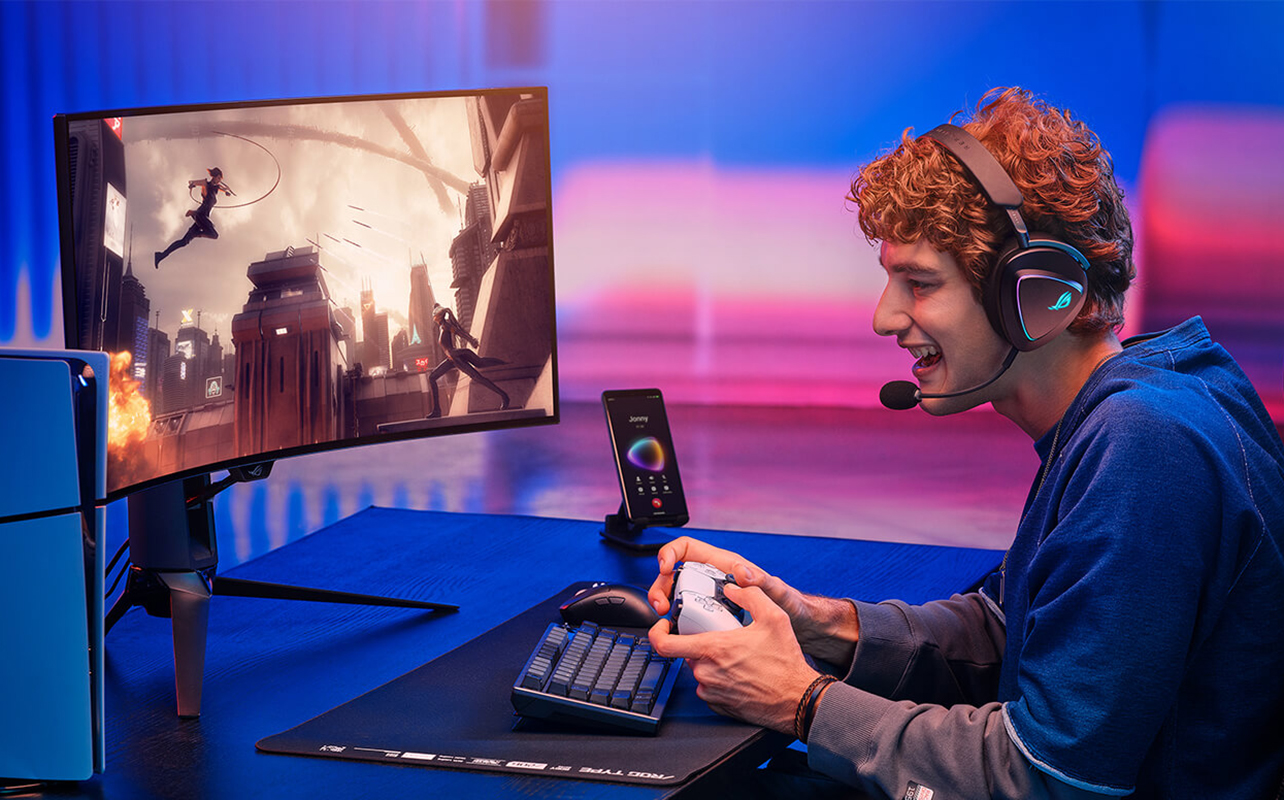
Shopping for a gaming headset is exciting but also a little confusing. There are plenty of models, some of which boast RGB lighting, surround sound claims, and futuristic features, so it can be hard to know which specs actually matter. The best thing to do in finding the right gaming headset is to look beyond the booming bass or flashy designs. Comfort, sound, and microphone quality are the true measure of how well the headset performs.
If you play for hours, chat with teammates, or stream your gameplay, you’ll quickly notice the difference between a headset that looks good on paper and one that feels great in practice. In this guide, we’ll break things down based on those simple principles of comfort, sound, and mic performance to help you pick the right model for your playstyle.
Comfort: a headset you can wear for hours
Comfort isn’t glamorous, but it’s essential. Even the best-sounding headset won’t help if you’re constantly readjusting it or dealing with sore ears. Here’s what to look for:
Over-ear vs on-ear vs in-ear
- Over-ear headsets surround your ears entirely, providing the best balance of comfort and isolation.
- On-ear models rest on your ears, which can get uncomfortable during long sessions.
- In-ear (gaming earbuds) are lightweight and portable but lack the same immersion.
For marathon gaming, over-ear is almost always the winner.
Headband design
Look for adjustable sliders, suspension bands, and memory foam cushions. These details spread out pressure and prevent sore spots at the top of your head. Designs can vary pretty significantly when it comes to the headband, so pay close attention if your past experience tells you that more or less padding rests most comfortably on your head.
Ear cup padding
Ear cups are the most likely to offer extra padding, though not all gaming headsets are made that way. The key is what you personally prefer when it comes to the fit you want.
- Mesh is breathable but may leak more sound.
- Leatherette feels plush and blocks noise but traps heat.
- Hybrid designs try to give you the best of both worlds.
If you tend to overheat or play in warm rooms, breathable mesh or hybrid padding can be a lifesaver.
Weight distribution and clamping force
A lighter frame means less fatigue. Clamping force (how tightly the headset grips your head) should be snug enough to stay put but not squeeze uncomfortably.
Glasses and head size considerations
If you wear glasses, look for headsets with softer ear cushions and flexible frames. Adjustable designs also help accommodate different head shapes and sizes.
Bonus comfort features
Rotating ear cups, removable pads for cleaning, and ultra-light wireless builds are small touches that add up when you’re gaming for hours.
Sound quality: immersion and precision
Sound is what pulls you into a game world and potentially give you an edge in competitive titles. Here’s how to evaluate it:
Stereo vs surround
- Stereo (2-channel) is perfectly fine for casual gamers and often provides the most natural sound for music.
- Surround sound gaming headset options (virtual 7.1, Dolby Atmos, or spatial audio) create a 3D soundscape that makes it easier to locate footsteps or gunfire in FPS titles, as well as more distant directional sounds in various other titles. Think of open world games where all sorts of things happen. Tracking where the sounds come from can help you determine your next move.
Driver size
Bigger drivers (like 50mm vs 40mm) can deliver stronger bass and louder volume, but tuning matters just as much as size. Don’t be convinced by a higher number because a well-tuned 40mm driver can sound fantastic.
Closed-back vs open-back
- Closed-back headsets block outside noise and boost bass.
- Open-back headsets let air and sound flow more freely, creating a wider soundstage—but you’ll also hear more of your surroundings.
ANC (active noise cancellation)
Mostly found in premium wireless models, ANC reduces background noise. It’s great if you game in a noisy environment.
Wired vs wireless
- Wired: Instant response, no batteries to worry about, and often cheaper.
- Wireless: Modern 2.4GHz models have near-zero latency, long battery life, and more freedom of movement.
Dual wireless (Bluetooth + 2.4GHz)
This feature lets you connect to two devices at once—for example, chatting on Discord via Bluetooth while gaming on PC with a low-latency dongle. It also keeps you connected to your phone in case you need to take an important call. Perfect for multitaskers.
Software tuning
Many headsets come with companion software that allows EQ presets, bass boost, or adjusting the game/voice mix. This can really tailor the sound to your preferences. Customization may not end there, especially if the software also lets you make various other adjustments to personalize how you want to hear a game’s audio.
If you’re serious about building your entire gaming setup, don’t miss this PC gaming buying guide, which covers everything from headsets to monitors and accessories.
Want to take your whole gaming setup up a notch? Explore how to choose the best tech accessories for gaming and streaming setups for more inspiration.

Mic quality: communication that’s actually clear
If you play online, stream, or just chat with friends, microphone quality is crucial. The best mic for a gaming headset is one that makes you sound natural and easy to understand.
Mic types
- Detachable boom mics: Great for flexibility.
- Retractable arms: Slide into the ear cup when not in use.
- Flip-to-mute: Convenient for quick silencing.
- Beamforming or built-in mics: Sleeker design, but quality varies.
Noise cancelling
Noise-cancelling mics filter out background sounds so your teammates hear you, not your keyboard or fan. In LAN situations where chatter from various players goes back and forth, clarity is of paramount importance, especially when playing as a part of a team. It doesn’t really matter if you’re an aspiring pro or just a seasoned casual gamer because you want to avoid any confusion in key moments.
Broadcast vs basic
Entry-level headsets are fine for casual voice chat, but streamers should look for higher-tier models with broadcast-style clarity.
Features to look for
- Mute toggle: Essential for privacy.
- Mic monitoring (sidetone): Lets you hear your own voice so you don’t shout.
- Gain control & sensitivity: Useful if you have varying speaking volumes.
Software enhancement
Some modern headsets use AI filters, noise gates, or voice shaping to make your mic sound studio-ready without extra gear. Companion software may even offer firmware updates to enhance or fix existing features—possibly adding new ones, too.
Use case breakdown: what should you prioritize?
The “best” headset depends on how and where you play:
- Casual gamer: Comfort, simple stereo sound, plug-and-play setup.
- Competitive/FPS gamer: Low latency, directional audio cues, noise-cancelling mic.
- Story-driven/RPG gamer: Spacious soundstage, long-wear comfort, spatial audio.
- Streamer/content creator: Premium mic clarity, dual audio channels, comfort for extended sessions.
- Cross-platform gamer: Compatibility with PC, Xbox, PlayStation, Switch, and mobile.
Extra considerations
Beyond the three pillars, here are a few more things to weigh:
- Wired vs wireless: Latency vs convenience, no charging vs all-day battery.
- Battery life: Expect 20+ hours as standard; some premium wireless sets offer 40–70 hours.
- Brand ecosystems: If you already use Logitech, SteelSeries, or Razer, their headsets integrate nicely with existing software.
- Build quality: Look for reinforced headbands, braided cables, or modular parts.
- Price tiers:
- Under $100: Basic but reliable.
- $100–$200: The sweet spot for comfort, good sound, and solid mics.
- $200+: Premium builds, advanced wireless, AI tuning, and extras.
Making the right choice for the way you game
Choosing the right headset is about finding balance. Comfort ensures you can play for hours without fatigue. Sound quality brings immersion and precision to your favourite titles. And mic performance lets you connect clearly with friends or your audience. When all three of those elements are in place, your gaming sessions feel even more enjoyable.
Mind you, there’s no one-size-fits-all answer. The best gaming headset for you depends on whether you’re chasing immersion, performance, or flexibility across devices.
If you’re still wondering about the best options for your needs, here are the best gaming headsets for every budget. You can also explore Best Buy Canada’s lineup of gaming headsets. You can compare models online or even test them in-store to find your perfect match.
This article was drafted using AI technology and then reviewed, fact-checked, and revised by a member of our editorial team.





